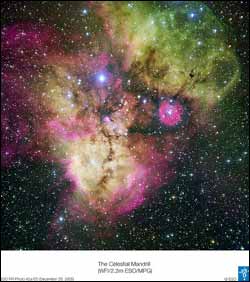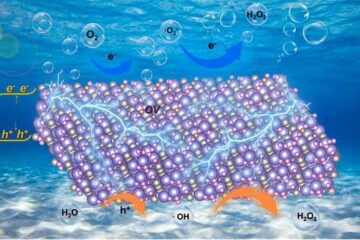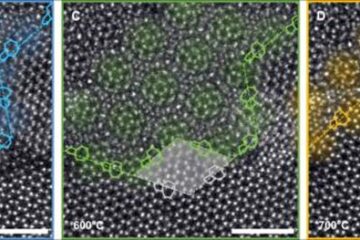The Cosmic Christmas Ghost

The Cosmic Christmas Ghost
Two Stunning Pictures of Young Stellar Clusters
Just like Charles Dickens’ Christmas Carol takes us on a journey into past, present and future in the time of only one Christmas Eve, two of ESO’s telescopes captured various stages in the life of a star in a single image.
ESO PR Photo 42a/05 shows the area surrounding the stellar cluster NGC 2467, located in the southern constellation of Puppis (“The Stern”). With an age of a few million years at most, it is a very active stellar nursery, where new stars are born continuously from large clouds of dust and gas.
The image, looking like a colourful cosmic ghost or a gigantic celestial Mandrill [1] , contains the open clusters Haffner 18 (centre) and Haffner 19 (middle right: it is located inside the smaller pink region – the lower eye of the Mandrill), as well as vast areas of ionised gas.
The bright star at the centre of the largest pink region on the bottom of the image is HD 64315, a massive young star that is helping shaping the structure of the whole nebular region.
ESO PR Photo 42a/05 was taken with the Wide-Field Imager camera at the 2.2m MPG/ESO telescope located at La Silla, in Chile.
Another image of the central part of this area is shown as ESO PR Photo 42b/05. It was obtained with the FORS2 instrument at ESO’s Very Large Telescope on Cerro Paranal, also in Chile.
ESO PR Photo 42b/05 zooms in on the open stellar cluster Haffner 18, perfectly illustrating three different stages of this process of star formation: In the centre of the picture, Haffner 18, a group of mature stars that have already dispersed their birth nebulae, represents the completed product or immediate past of the star formation process. Located at the bottom left of this cluster, a very young star, just come into existence and, still surrounded by its birth cocoon of gas, provides insight into the very present of star birth. Finally, the dust clouds towards the right corner of the image are active stellar nurseries that will produce more new stars in the future.
Haffner 18 contains about 50 stars, among which several short lived, massive ones. The massive star still surrounded by a small, dense shell of hydrogen, has the rather cryptic name of FM3060a. The shell is about 2.5 light-years wide and expands at a speed of 20 km/s. It must have been created some 40,000 years ago. The cluster is between 25,000 and 30,000 light-years away from us.
Note
[1]: NGC 2467 is also sometimes referred as the “Skull and Crossbones”.
Media Contact
More Information:
http://www.eso.org/outreach/press-rel/pr-2005/phot-42-05.htmlAll latest news from the category: Physics and Astronomy
This area deals with the fundamental laws and building blocks of nature and how they interact, the properties and the behavior of matter, and research into space and time and their structures.
innovations-report provides in-depth reports and articles on subjects such as astrophysics, laser technologies, nuclear, quantum, particle and solid-state physics, nanotechnologies, planetary research and findings (Mars, Venus) and developments related to the Hubble Telescope.
Newest articles

How 3D printers can give robots a soft touch
Soft skin coverings and touch sensors have emerged as a promising feature for robots that are both safer and more intuitive for human interaction, but they are expensive and difficult…

Oxygen vacancies mediated ultrathin Bi4O5Br2 nanosheets
… as efficient piezocatalyst for synthesis of H2O2 from pure water. As an important chemical raw material, hydrogen peroxide (H2O2) is widely applied in various aspects of industry and life….

Atom-by-atom: Imaging structural transformations in 2D materials
Silicon-based electronics are approaching their physical limitations and new materials are needed to keep up with current technological demands. Two-dimensional (2D) materials have a rich array of properties, including superconductivity…





















